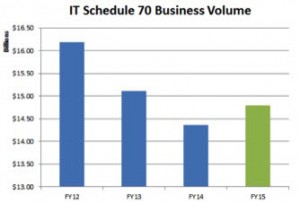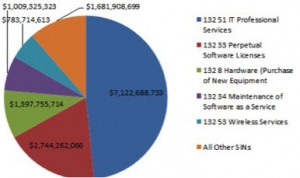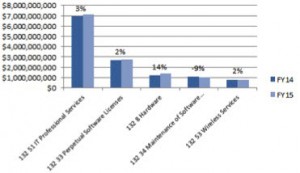(This blog post is part of a multi-week series reviewing data and trends from GSA’s IT acquisition vehicles for FY15. Read previous posts at http://gsablogs.gsa.gov/technology/.
Small Business GWACs: Year in Review
I’m proud to say that FY15 was a banner year for our Small Business Governmentwide Acquisition Contracts Center. The Center, which supports agency efforts to meet socioeconomic goals through IT services acquisitions, received 755 task orders in FY15. These acquisitions, and exercised options, represent a total government spend of $2.6B in obligations. Projects on these acquisitions represent a wide range of IT services, from technology consulting to cloud computing.
As the Center moves forward into FY16 with a number of new contract opportunities, its focus remains steadfast on helping small businesses succeed in the federal marketplace. Let’s take a brief look at the current contracts and what’s on the horizon.
Current Contracts
The Small Business GWAC Center currently operates three contracts with specialized socioeconomic designations. Each contract is designed to provide a streamlined method for agencies to utilize highly qualified small businesses to meet their IT needs, while achieving U.S. Small Business Administration (SBA) and agency socioeconomic contracting goals. Additional information on SBA goals may be found on the SBA website.
The 8(a) STARS II GWAC is a set aside contract for 8(a) technology firms (as designated by SBA). This contract is available for use through 2024, and includes nearly 600 skilled 8(a) IT service providers. In FY2015, more than $1.6 billion was obligated against more than 650 new task orders on the 8(a) STARS II GWAC. This represents the most successful year for 8(a) STARS II. More information on the 8(a) STARS II GWAC, including its directed order authority, can be found at 8(a) STARS II site.
The Alliant Small Business GWAC focuses on providing government contract opportunities to a wide range of highly qualified small businesses. This small business contract provides flexible access to customized IT solutions from a diverse pool of nearly 50 industry partners. With availability through 2024, Alliant Small Business allows for long-term planning of large-scale program requirements, while strengthening opportunities for small businesses. During FY15, Alliant Small Business received 90 task orders and over $1.2 billion in obligations. This is an increase of 8% in obligations from FY14. Details on how the Alliant SB contract can help your agency meet its goals are available at the Alliant SB website.
The VETS GWAC is a contract designed to strengthen federal contract opportunities for our nation’s service-disabled veteran-owned small businesses. Agencies receive SDVOSB credit when issuing tasks on the contract, which is available through 2020. The VETS GWAC continues to be a successful program, with nearly $139 million obligated on the contract in FY2015. The GSA VETS website has a wealth of information on how this contract assists in developing opportunities for SDVOSB firms.
Our small business industry partners, across all three SB GWACs have been very successful. On 8(a) STARS II, 378 out of 562 small disadvantage businesses (67.3%) have at least one award. On Alliant SB, 63 out of 68 primes (92.6%) have one or more awards. On VETS, 100% of the current SDVOSB contract holders have an award.
Next Generation Contracts
In addition to a focus on current contracts, the SB GWAC Center is currently working on three new acquisitions:
- 8(a) STARS II (set-aside for 8(a) firms) is currently conducting evaluations on an open season held in mid-FY15. This open season will provide opportunity to additional 8(a) firms to join the contract, increasing the pool of quality vetted 8(a) firms to meet federal agency requirements.
- VETS 2 (set aside for service-disabled veteran-owned small businesses) issued a draft RFP in 2015. This follow on contract will build upon the success of the original VETS contract, and include the capability to issue cost-type task orders. A final solicitation for VETS 2 is anticipated in FY16. For those interested in more information on the VETS 2 procurement, visit our VETS 2 Interact community.
- Alliant 2 Small Business (set aside for small businesses) held industry one-on-one sessions in FY16 for to develop the draft RFP. This next generation contract solicitation is anticipated to be issued in the spring of 2016. GSA invites interested government and industry partners to join our Alliant 2/Alliant 2 SB Interact community.
We are thrilled with agency interest in and use of the SB GWAC programs and are predicting a very successful FY16 as well. For more information on the SB GWAC program and how it brings small businesses and federal agencies together, please visit the SB GWAC website.
And, as always, please follow us on Twitter @GSA_ITS to join the conversation.


